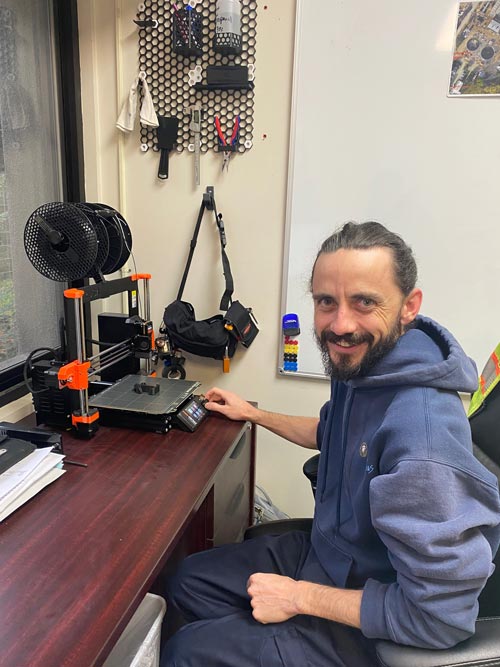
John Huggins, Chief Maintenance Technician for SLO’s WRRF
The San Luis Obispo Water Resource Recovery Facility (WRRF) uses 3D printers to make spare parts, especially those no longer available on the replacement equipment market. But it’s more than just having a 3D printer, says Patrick McGrath, WRRF Supervisor.
“Anybody can go to the store and buy a printer,” he says. “But to be successful, you have to have a 3D printer champion.”
At SLO, that champion is John Huggins, Chief Maintenance Technician. “He’s a man of many talents,” says McGrath. “It takes creativity, prioritization, and technical capability—and John is that perfect trifecta.”
Huggins, McGrath, and an operational staff of 11 are in the midst of a significant expansion project known as SLOWaterPlus. The upgrade will improve the plant’s efficiency while helping reduce the City’s dependency on reservoir and groundwater supplies long into the future. It will deliver significant long-term benefits to water quality, the environment, resilience and community education.
A membrane bioreactor system was installed last summer, along with new UV light disinfection. McGrath says the upgrades also include new solids handling equipment, stormwater retention basin, and a permanent odor control system. He says the community began planning the $140 million expansion project in 2014.
“It’s the largest capital project the city has undertaken,” he says. “Over the last 10 years, we’ve been really cautious with rate-payer dollars and made calculated decisions on what improvements or repairs we needed to conduct.
“The construction project has been really hard on our equipment,” McGrath adds. In some cases, replacement parts are needed, but due to the age of the equipment, the parts are no longer available, or lead times are prohibitive. The staff has to decide between ordering a new unit or figuring out a way to repair the existing one.
That’s where Huggins and 3D printing comes in.
A pump in the cooling tower controlling the temperature of plant effluent flowing to San Luis Obispo Creek was disabled when one of the motor fans exploded. “We could no longer find the fan and couldn’t purchase a replacement,” says McGrath. “We were faced with buying a whole new pump.”
Instead, Huggins took the existing fan, recorded dimensions, and essentially re-engineered the unit. Then he fed the data into the 3D printer, and by the end of the day, he was able to reproduce the plastic parts and glue them together to make a serviceable replacement fan.
“It’s been up and running for eight months with no issues,” says McGrath.
Another case involved a safety concern in one of the pump rooms in the new project. McGrath explains that a small solenoid valve designed to purge high-pressure air from the system was situated right at eye level of an operator standing close to the valve.
“It was a safety issue,” says McGrath, “and John worked with our safety director to design a solution.
Again, using the 3D printer, Huggins trouble-shot the piece and designed a turn-down nozzle that swept the high-pressure air being released downward, away from an operator’s eyes.
“Within three hours, John had designed and printed nine replacement valves, and they’ve already lasted six months,” McGrath says.
Huggins is self-taught and only has six years of experience in wastewater treatment. He started as a lab technician, then became an operator, and was promoted to his current position only last year.
“I’ve always been a tinkerer,” Huggins says. “I get immense joy out of creatively leveraging technology for practical problem-solving. 3D printing just made sense in the realm of water reclamation.” After the first printed solution was implemented, the momentum took off, and the entire team adopted this technology as a new tool in their toolbox. He knows how to adapt the technology to the real world, says McGrath. “He takes on a project and just runs with it.”
The printer has helped SLO conduct an effective public outreach program, as well. Every year, the city stages a public works and utilities night downtown, exhibiting trucks and equipment. Using the 3D printers, the water reclamation facility makes six-inch tall Tardigrades, also called water bears or moss piglets, complete with legs and claws, and raffles them off to kids. “We’ve got Tardigrades all over town, inspiring the next generation of water professionals,” explains McGrath, who studied to be a teacher before interning and joining the utility.
“3D printers can’t solve all our problems,” says McGrath, “but they can solve a lot, and they’re really helpful. They’ve saved us so many times.”
He highly recommends that every plant have one. But, he adds, in addition to the equipment, you’ve got to have that 3D champion.
Photos provided by City of SLO